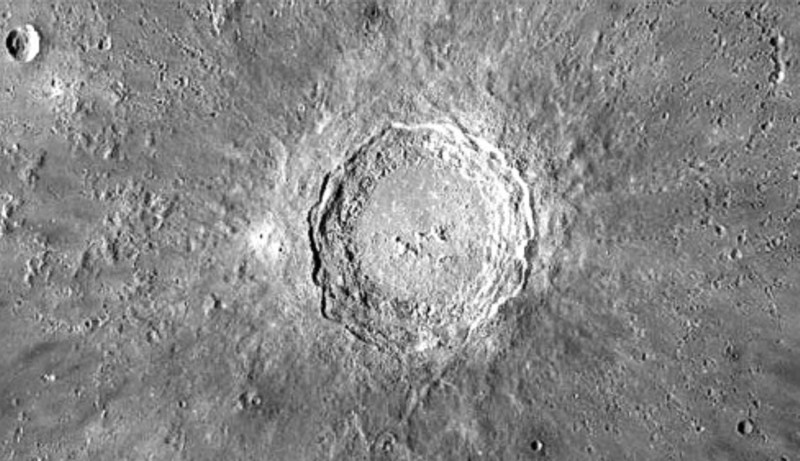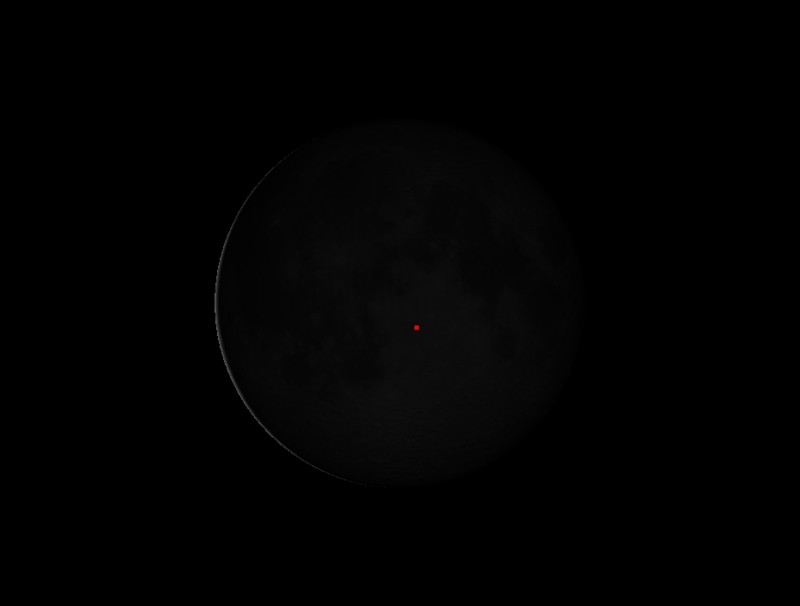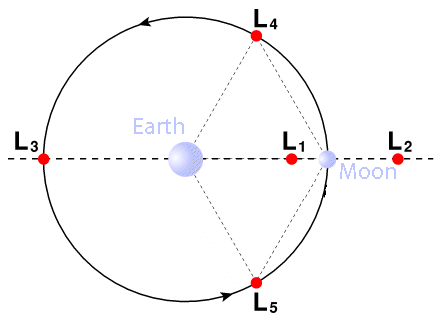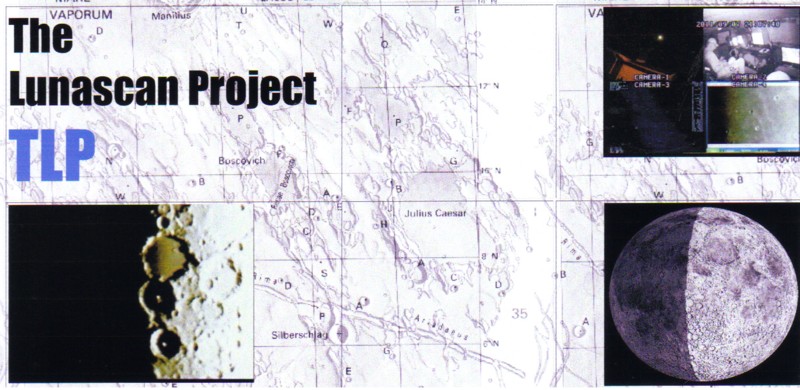Current lunar imaging is at the mercy of the
observer's location and time of day/night and
weather! Speaking from experience, we of the
Lunascan Project have had almost a hundred
scanning missions since the Project began in 1997.
The most missions conducted in any given year was
a dozen, and many of those were performed under
limited sky conditions. It's time to change all of
this. We have weather satellites looking at the
Earth 24/7. Why can't we have one satellite
watching the near side of the Moon? And if
that can be done, why not have several, one placed
on the far side?
You go to your computer and click on
"RIPTILA". The site takes you to a screen with
live High Definition images from the Moon
similar to the above, being imaged at 30 frames
a second. Viewed full screen on your 52' LCD
monitor, the bright, contrasted, full image of
the Moon floating in the blackness of space in a
close-by stationary L-1 orbit is breath-taking.
This view is not magnified. It will a filtered,
camera eye view, streaming live from RIPTILA's
imaging platform. On the bottom of the screen
will be fast-running time stamp in Coordinated
Universal Time. Anyone will be able to access
this site and at any time (*) of the month or
day and view this live image just like they do
with a U.S. weather satellite, but this time it
is our nearest neighbor, the Moon.
To get a closer look, using your mouse and a
special program, you place a small rectangle
over a portion of the Moon. With a right-click
you are now looking at that small section pumped
up, full screen and in HD, a SIMRANGE of 300
miles and a field of view of 200 miles. This is
an unobstructed, clear and sharp view of the
lunar surface. Not the latest image, but LIVE
images! On command you can zoom in even closer.

52-mile wide Copernicus in a 200 mile FOV
Does this sound far-fetched? Or a
waste of taxpayer's money? At one time
weather satellites running 24/7 over the
U.S. were just a great idea. We already
have the technology. If
SOHO can do this
with the Sun 93,000,000 miles a way, why
can't it be done with the Moon? The
DSCOVR satellite is located near the L1
point between the Earth and the Sun. Its
position is maintained by firing of
rocket motors. (See L1 and "halo" orbit
below ). There is a very strong
possibility that a project like this
could get off the ground with NASA or
SPACE-X or some other privately-funded
mission. At the time of this writing we
already have a project underway called
Gateway. All one has to do is add the
RIPTILA mission to the project plan.
But what would RIPTILA do and why the
need to do it?
WHAT ARE TARGETS OF
INTEREST?
1. METEORITE IMPACTS
Probably one of the most important
aspects of RIPTILA would be the 24/7
scan of the lunar globe for meteorite
impact flashes. What is happening on the
Moon today is also happening on the
Earth, today. Impacts are still
occurring and a more comprehensive study
of them might help us to understand the
rate and periodicity. This could help
predict and deter a potential global
disaster from the threat from rogue
asteroids. In the image at the top of
this proposal is a view of the Moon's
western hemisphere, perfect for those
looking for anomalies and routine
targets on the dayside, and great for
meteorite impact hunters on the
darkside. Even more interesting would be
the New Moon's totally black surface
with the perfect backdrop for impact
flashes. (See below). The other times
when watching the Moon would be valuable
would be during "meteor showers" which
occur about a dozen times a year. Not
only would this be live, but a
photo-cell type system could even do the
tedious work of counting the impacts.
State-of-the-art security surveillance
systems could store high-quality images
for periods as short as a single day.
During the last decade many astronomers
have been watching the dark side (which
also changes every day) for meteorite
impacts, and there have been several
documented cases. RIPTILA opens up a
wonderful opportunity for scientists and
researchers to study the Moon live and
24/7. This could be done in MUCH higher
resolution than with Earth Based
Telescopic Images and scanrate on a
daily basis, and recordings reused many
times.

New Moon
2. LUNAR TRANSIENT PHENOMENA
"LTPs") have been
observed since 1783, and the reported
activity in some cases may be an
indicater that the Moon is not as dead
as we had once thought. This
exciting and promising new idea may
change the way we watch the the Moon and
there would no longer be any weather
problems as we encounter with
earth-based telescopes. Teams can be
anywhere in the world at any time of the
day or night. And requests for viewing
"Targets of Interest" at specific times
would keep scientists and researchers
busy doing very important and exciting
work.
3. ROUTINE SCANS
Using the mouse, the team slides the camera in
the steerable mode to the upper right of the
lunar disc and lets the program pan/scan the
Moon at the rate of their choice. All the while
the live images are being recorded. If the team
wants to take a closer look at a target, there
is no earth-rotation to deal with here, the
system is just in "pan" mode. With another click
on the mouse the team can now switch to track
mode and hit "zoom". Now at higher power the
target is observed extremely clear at a
resolution not possible with EBTI or
"Earth-Based Telescopic Imaging".
4. MISSION IMAGING
Since we are going back to the Moon there will
be many missions on the lunar surface. RIPTILA's
cameras can be used for this purpose.
Authorized and scheduled teams can observe
Targets of Interest, using this steerable
high-definition telescopic system "hovering"
over the lunar nearside. While they work the
mission, people all over the world could also
watch "the Moon Channel" as live breath-taking
images come in. Viewers seeing "flashes" or
possible "anomalies" can phone in reports as
they occur and be credited for their finds.
There is a long list of LTPs with dates and
times so that colongitude can predict an
occurrence if lighting conditions had anything
to do with it. When there is no specific
mission, the spacecraft's surveillance would
continue its routine "meteor watch" 24/7.
MISSION REQUESTS
Originally it was thought that teams wanting to
do a "meteor watch" during an intense meteor
shower known to be going on on the Earth would
have to file a "Mission Request" which would
allow them priority over the RIPTILA view. But
this wouldn't require any more than the image of
the full lunar disc to observe the flashes of an
impact. A message on the bottom of the
screen ("ticker" or "crawler") would inform
everyone that some type of mission is going on.
The same with an authorized team for research on
a past LTP report. LTP dates and times would
have the colongitude data and a computer
program would provide the future dates for the
exact same seeing conditions to try to duplicate
the event if specific lighting caused the
anomaly or if lighting conditions betrayed the
presence of any unusual feature or outgassing.
Most of the time between these more important
activities would be filled in with routine
scanning which would still benefit the "meteor
watch" aspect. We always see the eastern
hemisphere in normal hours and most of the
previous 99 missions here at the Lunascan
Project involved that area. But the western part
of the Moon is for the early bird. It's one of
the most interesting sights to see if you like
the north-western part of Mare Imbrium with the
beautiful Sinus Iridium, and the Jura mountain
range which forms its edge. Sinus Iridium is
crossed by mare ridges. Luna 17, which landed to
the south of Cape Heraclides, transported an
automatic mobile laboratory, Lunokhod 1, to the
Moon. The interesting target craters Kepler and
Aristarchus are always a favorite. But having a
mission in the wee hours with good seeing
conditions is a long shot in may places of the
world. RIPTILA would solve that problem. Teams
wouldn't have to have expensive telecopes to set
up and maintain. All they would need would be
the will to work the scans, a computer, and a
recorder.

Lagrange Points
A word about Lagrange points and halo orbits. A
halo orbit is a periodic, three-dimensional
orbit near the L1, L2 or L3 Lagrange
points in the three-body problem of orbital
mechanics. Although a spacecraft in a halo orbit
moves in a circular path around the LP, it does
not technically orbit the actual Lagrange point,
because the LP is just an equilibrium point with
no gravitational pull, but travels in a closed,
repeating path near the Lagrange point. Halo
orbits are the result of a complicated
interaction between the gravitational pull of
the two planetary bodies and the coriolis and
centrifugal accelerations on a spacecraft. Halo
orbits exist in many three-body systems, such as
the Sun/Earth system and the Earth/Moon system.
Continuous "families" of both Northern and
Southern halo orbits exist at each Lagrange
point. Because halo orbits tend to be unstable,
stationkeeping is required to keep a satellite
on the orbit. The distance from the Moon is
around 384,400 km (240,000 miles) and the LP
would be at about 62,000 km (about 39,000 miles)
and require more complicated optics on REPTILA.
But optics, of Hubble quality, but higher power
in space would be fantastic as compared to
Earth-bound systems with global atmospheric
problems.
If successful, using a relay satellite orbiting
the Moon to send the images, another version of
our project could be used for the Lunar Far Side
in a much more stable L2 Lagrange Point.
RIPTILA is a suggested name only. And how to
create an orbiting lunar satellite that would
utilize an LP is a problem worth solving. Once
we establish enough interest we can work on the
issues and those problems. I don't believe the
funding would be that difficult. I think the
benefits would be scientifically valuable, and
that the use of the system would be the
beginning of a new era in space as we continue
to explore the Moon and prepare for the next
generation of more intense explorations and
adventures, both private and commercial.
Already on the drawing board are new ways to use
the newest technologies. One idea is to use one
camera to do the entire operation, the original
image being as hi-res as can be obtained. Then,
on the ground, using computer programs, zooming
in to produce what we use to call MPS and HPS
scans. Medium Power Scanning produced images
similar to a good telescope where the FOV was
over 400 miles and up to 1,000-2000 miles. HPS
(High-Powered Scanning) was 400X (or more) with
an FOV under 400 miles, such as the pumped up
image of Copernicus above with an FOV of 200
miles.
Using a computer program or a RIPTILA "x-box",
anyone could do their own experiments without
affecting the authorized missions. Rather than
just watching scientist and researchers do their
work, amateurs would be able to use the system
without having to buy a telescope. Telescope
suppliers could sell the "R-box" just as they
sell telescopes for people to watch the Moon.
RIPTILA will never replace the telescope for
amateur astronomers who have a wide range of
interests in space, but for those interested in
the Moon it will open a whole new world in space
adventure as we go back to our neighbor a
quarter of a million miles away.
Once Gateway is operational, all they would have
to do is mount a camera outside facing the Moon.
Sincerely,
Francis L. Ridge
* At times when the Sun would be in the
background, and this would be once a month
and for a short period, there would have to be a
way of turning on a filter or be able to shut down
the camera to protect the optics and scanning
chip.




